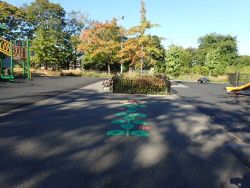Rudd Playground
Rudd Playground
What was here before?
This site was once a forested area that was chartered in 1661 by Peter Stuyvesant, Director General of New Netherland. The name, Bushwick, comes from the Dutch word “boswijck,” meaning “refuge in the woods” or “heavy woods.” Settled in the 19th century by tobacco and grain farmers from France, Scandinavia, England, and Holland, Bushwick boasted eleven breweries on a fourteen-block stretch known as Brewer’s Row by the mid-1800s. Joining already established sugar, chemical, and oil industries, manufacturer and onetime presidential candidate Peter Cooper built his first glue factory here in the 1840s.
After Bushwick was incorporated into the City of Brooklyn in 1854, the subdivision of farms, begun by Adrian Martenses Suydam in 1869, led to a population boom. Bushwick’s growth gained even more momentum after 1888 when railway access made it easier to commute to Manhattan. Bushwick became increasingly attractive to professionals. In the 21st century, Bushwick became home to numerous ethnic groups that have given the neighborhood a unique imprint.
How did this site become a playground?
The City of New York acquired the site in 1928 for use by the Department of Transportation in connection with transit construction. NYC Parks received a permit in 1936 to operate a portion of the land as a playground. The Department of Transportation surrendered the entire site to the NYC Parks in 1954 and expanded the existing park. The playground was renovated in 2020 to update the skate park and basketball courts.
Who is this playground named for?
In 1936, this playground was named for Stephen A. Rudd (1874-1936), a lifelong resident of Brooklyn who represented his community in different political offices. An alumnus of Brooklyn Law School and St. Lawrence University, Rudd married Elizabeth Lindsay in 1895. Following his admission to the New York State Bar Association in 1914, Rudd joined his family’s practice of Rudd, Rudd & Rudd in Brooklyn. A universally respected Democrat, he was elected to the Board of Aldermen in 1922, a position he held for eight years. In 1931, he was elected to the House of Representatives as a member of the 72nd Congress. Elected to the 73rd Congress in 1933 as a representative of the 9th New York District, Rudd served in that capacity until the year before his death.
Check out your park's Vital Signs
Clean & Safe
Green & Resilient
Empowered & Engaged Users
Share your feedback or learn more about how this park is part of a
Vital Park System





